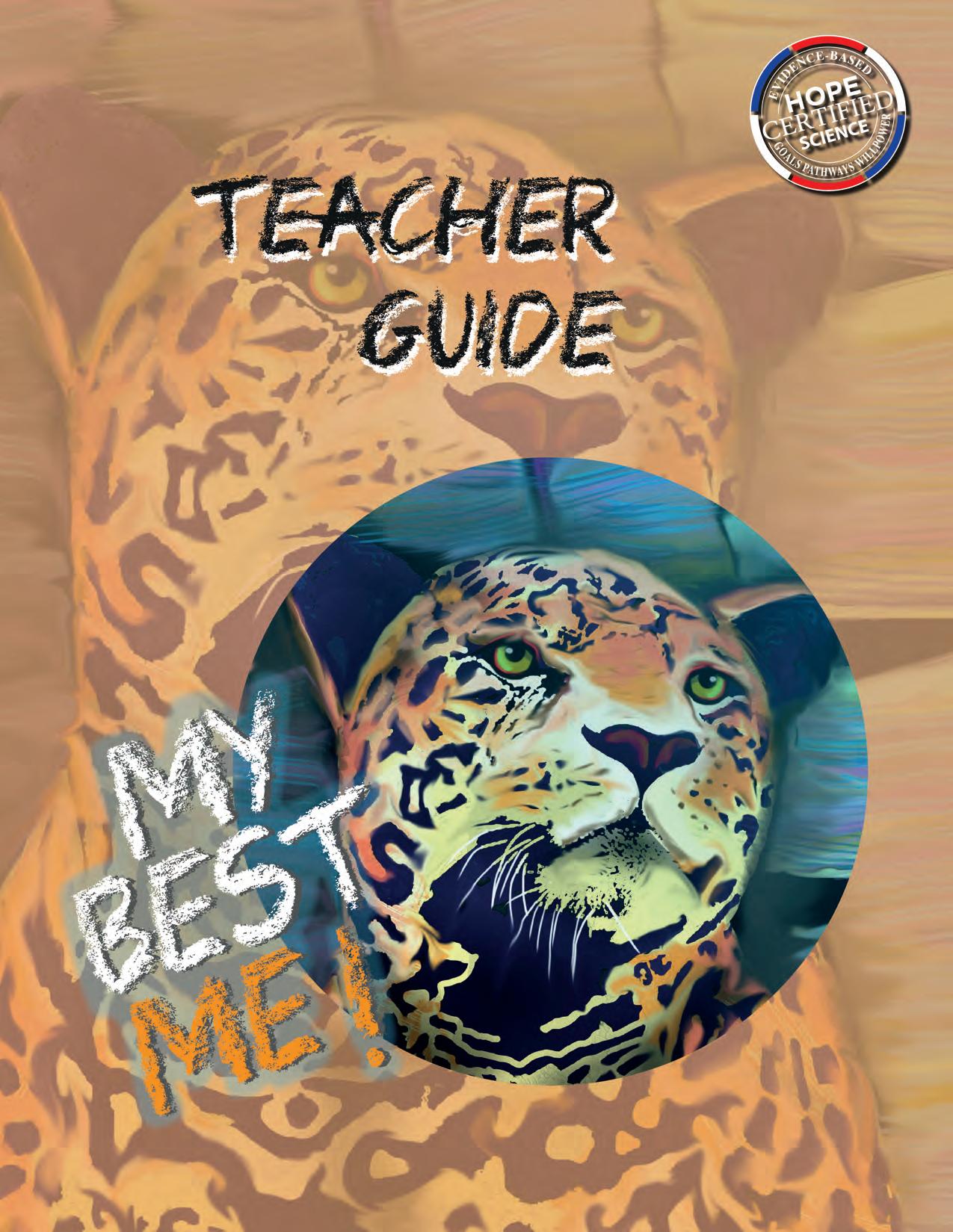




Hope is the belief that the future will be better than today and that you play a role in making it possible. It is not wishful thinking. Hope allows you to identify goals you value, set pathways to achieve them, and employ the willpower to successfully complete those goals you have chosen.
My Best Me is a series of lessons designed to stimulate students to discover their true identity and purpose. My Best Me delivers hope through implementation of a Social Emotional Learning (SEL) methodology that has shown to enhance students’ cognitive competence and give them the integrated skills they need to deal effectively with daily challenges in an ethical, effective manner. My Best Me incorporates both intra- and interpersonal conversations as well as other participatory experiences into five core competencies powered by seven principles. Your investment in elevating hope will result in greater and more enthusiastic student participation, uninterrupted classroom instruction time, and a superior learning environment.

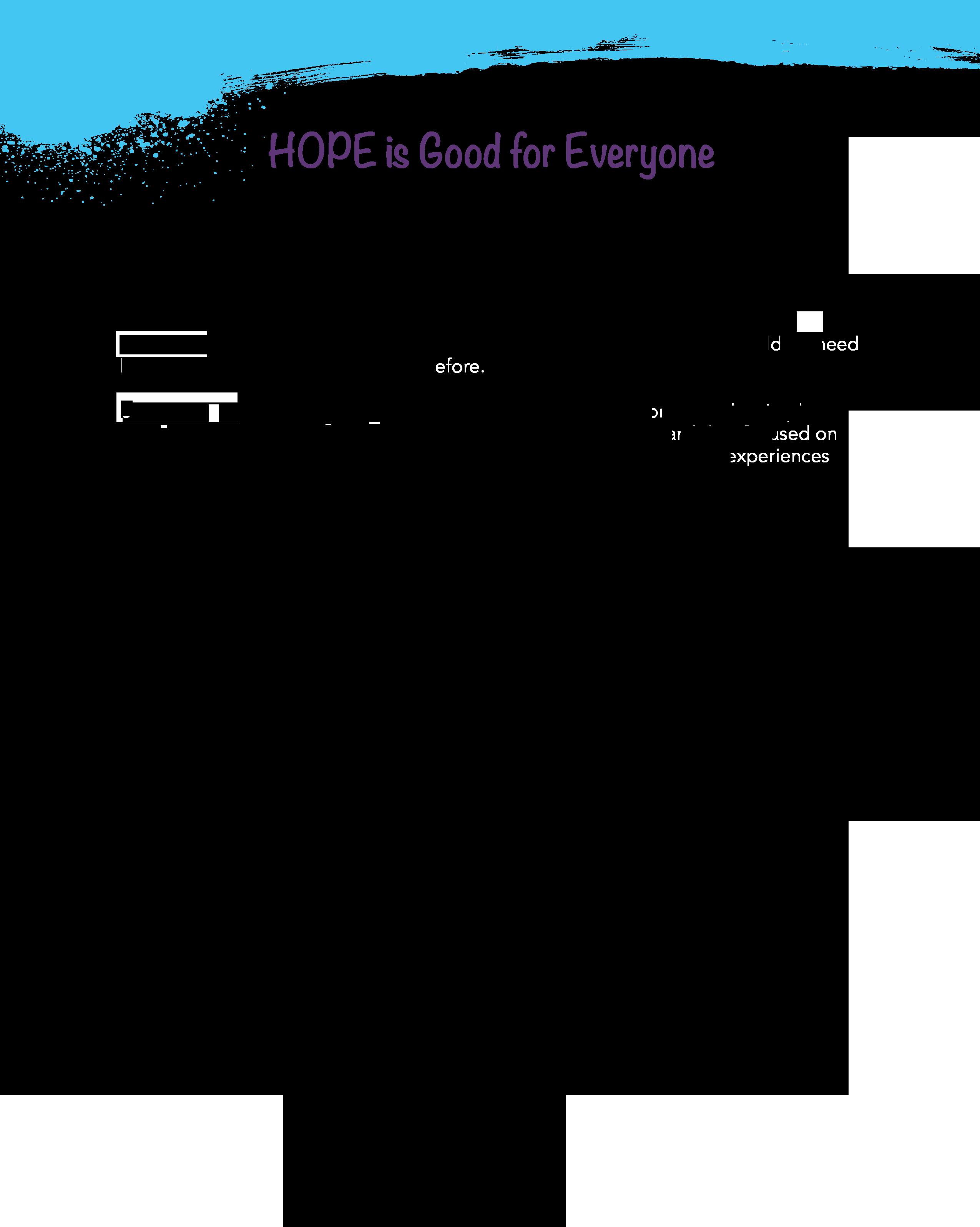
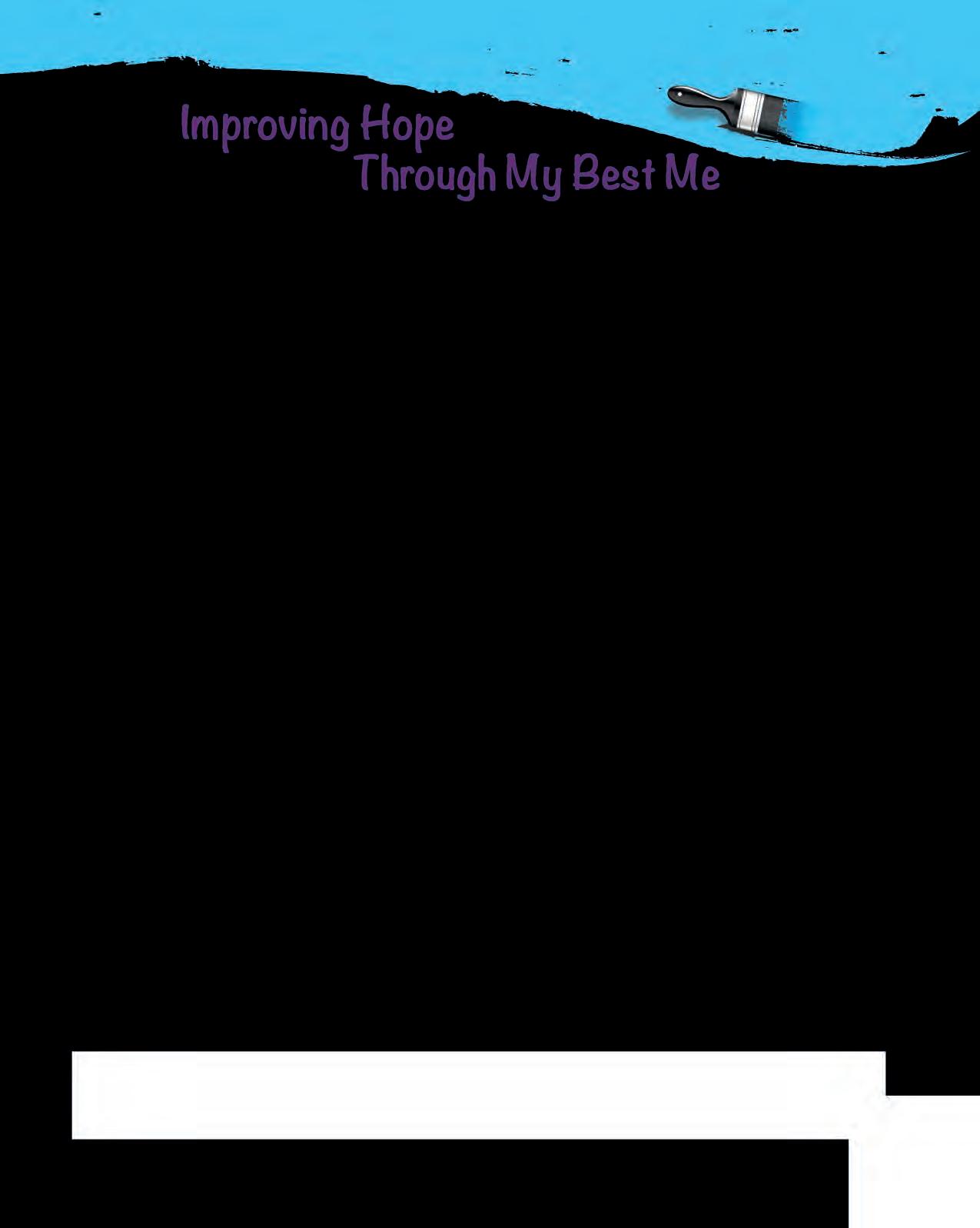
My Best Me textbook, journal, paper, pencil, audiovisual equipment
RESOURCES: Video - Dream Interpretation: What Do Dreams Mean? - Link: 4yu.info/?i=95072 Video - Something straight from the heart - Link: 4yu.info/?i=95074 Video - How Brandon Kelman’s dream became real - Link: 4yu.info/?i=95071
: Discover that well-being is all about personal.
: My Best Me textbook, journal, paper, pencil, colored pencils for sketching
: Discover how balance and order enhance overall wellbeing MATERIALS: My Best Me textbook, journal, paper, pencil, ingredients to make a sponge cake (mixing bowl 9 inch baking pans (2), oven, sifter, mixer, measuring spoons, parchment paper, eggs, sugar, flour, baking powder
SUMMARY: Discover how growth happens with a correct mind set MATERIALS: My Best Me textbook, journal, paper, pencil, audiovisual equipment
: Video - Growth mind set - Link: 4yu.info/?i=96511 Video - Learn how to soar - Link: 4yu. info/?i=95101 Video - Michael Jordan on overcoming failure - Link: 4yu.info/?i=95102
SUMMARY: Discover the need to guard what you let into your life.
MATERIALS: My Best Me textbook, journal, paper, pencil, glass of clean water, glass of dirty water, glue, construction paper, markers, color pencils, scissors, newspapers, old magazines, personal photo of each student, etc.
: Discover how to handle challenging and dangerous (peer) interactions. MATERIALS: My Best Me textbook, journal, paper, pencil, markers, posters, and materials to make posters or other work of arts like molding clay, wood, crepe paper, etc.
: Discover how a daily routine of exercise enhances health.
MATERIALS: My Best Me textbook, journal, paper, pencil, audiovisual equipment RESOURCES: Video - Stress management strategies - Link: 4yu.info/?i=95131


the skills needed to fulfill dreams.
Me textbook, journal, paper, pencil, access to library and/or internet, audiovisual equipment
My
Discover how hard earned money is so easily spent. MATERIALS: My Best Me textbook, journal, paper, pencil, access to the internet, audiovisual equipment
: Video - “A Penny Saved is a Penny Earned,” in the Schiel Wealth Management series - Link: 4yu.info/?i=95271 Website - How the average American spends their pay check - Link: 4yu.info/?i=95272
Discover that the value of a country’s resources are determined by people.
: My Best Me textbook, journal, paper, pencil, computer for research, dictionary, large poster paper or poster board, scissors, glue, access to a printer or old magazines
Discover the key to success is discipline.
My Best Me textbook, journal, paper, pencil, computer for research and class work
READ
A story, a poem, a saying, or a script that adds to the subject
To obtain knowledge, insight, and understanding through information
To look, see, find, watch, and discover more
To paint, color, or make in a personal manner
PLAY
Engage in an experience and discovery together
WRITE
To write, mark, or sketch personal ideas or discoveries
APPLY
To bring into action, put to use, and demonstrate understanding
GIVE

A contribution, present, or surprise to share with others
ACT
A task that involves direct experience and action
Discuss, consider, or examine certain subjects
Think, ponder, meditate, or wonder about important issues
To learn, write, sing, or listen to a song; enjoy a harmony of sounds
CONCLUDE
A closing statement on the lesson subject with a final thought
WATCH
Watch a clip or film section and analyze the information
My Best Me textbook, pencil, journal, paper
Resources
Student Worksheet: 4yu.info/?i=V598506
Family Engagement: 4yu.info/?i=V598556
Glossary
recording, imitating, instinct, innate, moral, alternate, conduct, manifests, brainstorm
Motivation
Humans are a unique species, and although we share many physical characteristics with animals, we also have many special characteristics that set us apart from them. Humans, unlike animals, have the ability to make moral decisions, plan for the short and long-term future, consciously decide to help others, love, appreciate beauty, celebrate life, make jokes, create meaning with words, gain wisdom, seek the meaning of life, and much more. Although all life on Earth is important, and therefore to be valued and respected, human life is set apart.
Humans are responsible for the management and administration of all other creatures, of nature, and all the resources this planet provides. We have the capacity to steward this world in ways that cause it to flourish and prosper. To do so, however, we need to be morally principled and willing to sacrifice our selfish desires for the well-being of others. That is the key to humanity.
The students will be able to clearly identify the main differences between humans and animals. We are capable of making moral decisions and creating ingenious objects and services for the benefit of society.
Play: What would a __________ do in front of a camera? The students will have the opportunity to act out or describe a certain animal’s behavior with a partner. The purpose of the activity is to get students thinking about how animals behave differently than humans, and why they behave differently. Some animals share similarities, but many characteristics, such as the human brain (and its capacity) and the different dimensions of our existence, set humans apart from all other creatures.
Comment: In this section, students will use the workbook questions as a guide to considerations about
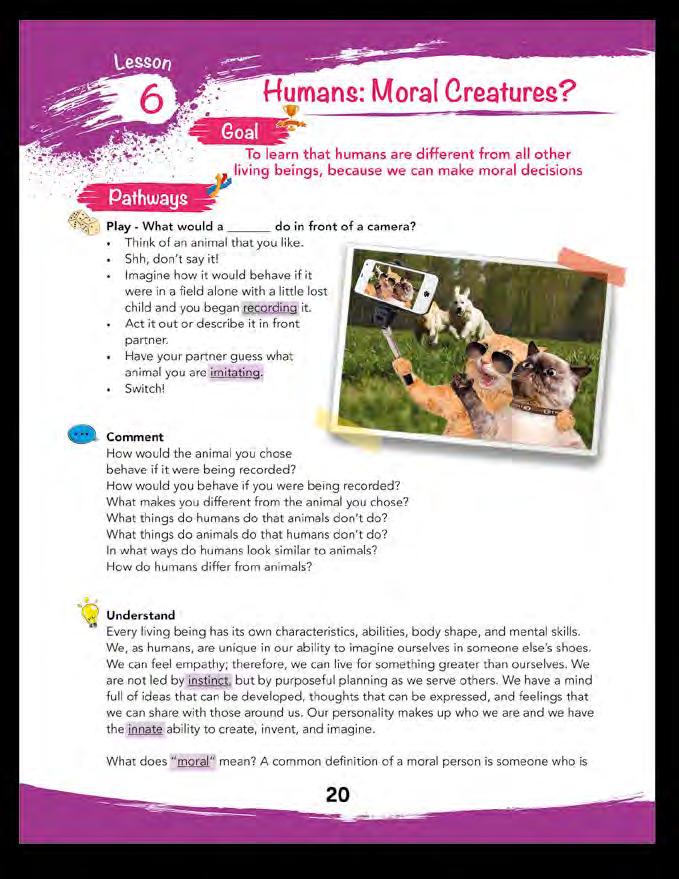
the differences and similarities between humans and animals. Motivate students to focus on the superiority of the human creature as a being. Of course, as complex beings with the ability to act in healthy and unhealthy ways, humans are also capable of inhumane acts and behavior—far worse than any animal could ever display. Help students grasp the great responsibility that goes along with the ability to make moral decisions. Feel free to use online resources for students to research this topic in more depth. And although it might seem like a simple topic, there is a lot of complexity here. Students can also create Venn diagrams, Power-point presentations, or posters to showcase their research findings.
Understand: Read the Understand section together, emphasizing the differences between humans and animals (If students conducted research and presented it to the class, this may have already been discussed). Be sure to direct the students to stories and inventions that have helped people and made the world a better place. Due to our unique
capacity as human beings endowed with free will, there are many heartbreaking examples of horrors caused by humans. However, we want to inspire the students to improve the world they are inheriting. We want them to take responsibility and use their dreams and abilities to impact humanity in constructive ways.
Act: Honoring My Friends
This is a simple act of moral decision to build the morale of another student. Each student will write a constructive letter to a classmate assigned to them. We want to make sure each and every student is honored. The goal is to honor that student and recognize their unique and special characteristics, and to motivate them to become the best they can be. This activity serves to display human characteristics at their best while honoring and uplifting a friend.
Give: Conduct a ceremony in which students will exchange their letters in a significant manner, as a gift to their partner. Encourage students to receive their letters with the appropriate enthusiasm and gratitude.
Reflect: Give students time to think about the questions presented. Perhaps invite them to write down some of their thoughts in their journals. You can also close this session by inviting students to share those thoughts with the class.
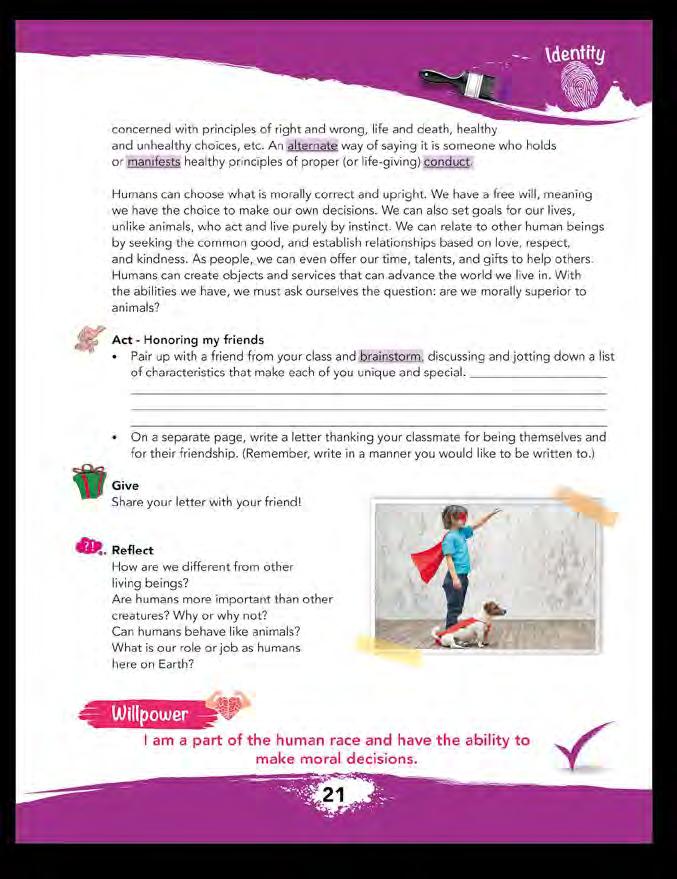
An important part of understanding our world is the realization that humans are a unique species with the ability to make both healthy and unhealthy decisions. Each of us must understand the consequences of our decisions for ourselves as well as their impact on others.
My Best Me textbook, journal, paper, pencil, audiovisual equipment
Resources
Student Worksheet: 4yu.info/?i=V598511
Family Engagement: 4yu.info/?i=V598561
Videos:
Growth Mindset - Link: 4yu.info/?i=96511
Learn How to Soar - Link: 4yu.info/?i=95101
Michael Jordan on overcoming failureLink: 4yu.info/?i=95102
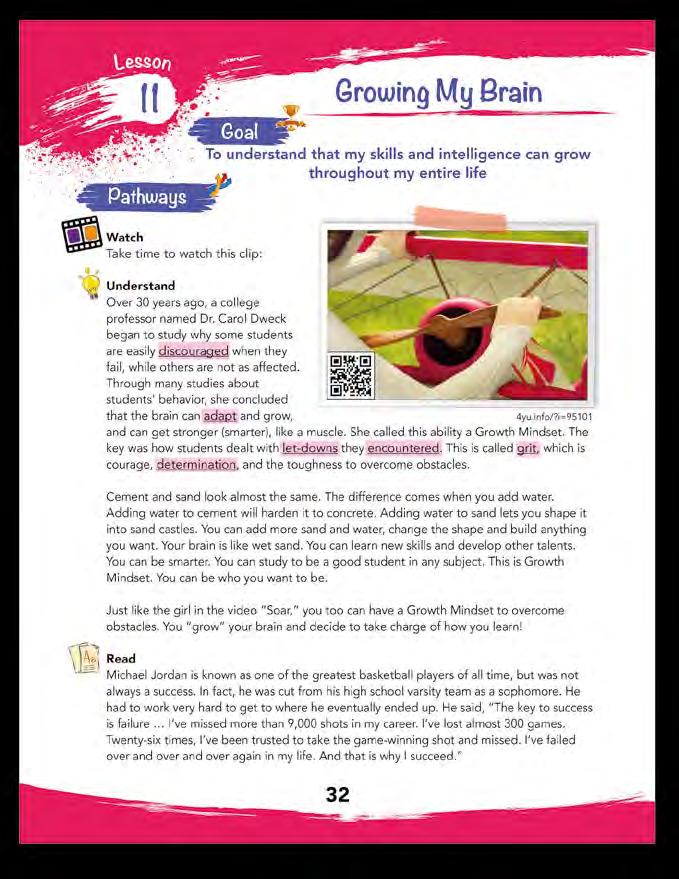
discouraged, adapt, let-down, encountered, grit, determination
Motivation
We have all heard the assertion that we only use about 10% of our brain’s capacity. Did you know that this is actually a myth? But the problem remains: how do we learn to use more of our brain, and do so more effectively? For years, there weren’t any clear answers, but recent discoveries in neuroscience reveal there are actions we can take to grow our brain’s potential. What great news, not only for us, but for our students! The purpose of this lesson is to expose your students to the radical idea that their brain power is not “locked” or fixed; rather, they can activate their brains to do things they never thought they could do.
Our society is very good at telling us what we cannot do. Children are surrounded by limiting messages such as, “Some people just aren’t good in math and science,” or, “Just focus on the things you do well, because you will never be strong in other areas.” One of your roles as teacher is to open a new window for your students’ understanding of the virtually unlimited potential of their brains.
Your students will learn that a Growth Mindset (or mental outlook) will help them “own” their learning process in every area of their lives, and that they are capable of doing whatever they set their mind to.
Watch: Have your students watch the video called “Soar” and then have them describe the difference between Growth Mindset and Fixed Mindset.
Encourage your students to name some people they know or have read about who exemplify a Growth Mindset. Why do they think this person had a Growth Mindset? What did they do that was different than what a person with a Fixed Mindset would do? Have your students share moments in their lives when they had a Growth Mindset and achieved something they
previously thought they could not do.
Understand: Read this quote from Dr. Carol Dweck, who says this about a Fixed Mindset: “In a fixed mindset, students believe their basic abilities, their intelligence, their talents, are just fixed traits. They have a certain amount and that is that, and then their goal becomes to look smart all the time and never look dumb. In a growth mindset, students understand that their talents and abilities can be developed through effort, good teaching, and persistence. They do not necessarily think everyone’s the same or anyone can be Einstein, but they believe everyone can get smarter if they work at it.” (Source: 4yu.info/?i=95102)
Watch: After reading about Michael Jordan and watching the video, ask your students what would have happened to him if he had given up basketball when he failed to make the varsity team as a sophomore in high school (In other words, if he had given up on pushing himself further than he had ever gone before).
Write/Act: As the students answer the questions, they will also take part in one of the mini-workshops in class to help them grow in one or more areas. Have them consider one aspect of their life where they think they are weak or “stuck.” It could be a school subject (e.g. math, reading, science), or perhaps a challenge at home (e.g. forgetfulness about chores, irritation with siblings, etc.). In addition to participating in the mini-workshop, each student will choose a partner to share their experience. Now have the students write down 3 practical things they can do each day for the next 21 days to change their way of thinking and move from a Fixed Mindset toward a Growth Mindset.
Neuroscience has shown that it takes 21 days for a new concept to move from short-term to long-term memory. At the end of their “21-Day Challenge,” have students discuss their personal results with their partner.
Reflect: As the students reflect on their new-found understanding of the contrast between a Growth and a Fixed Mindset, challenge them to see how their perceived “weaknesses” (as explored above) could be turned into a strengths. Why do they—or don’t they—think this is possible?
Students will understand that the brain works much like a muscle, in that the more you work it, the more it grows! Repeating new words and new actions allows the brain to make new neural pathways, strengthening the brain’s abilities. This is why the 21-Day Challenge is so helpful.

My Best Me textbook, journal, paper, pencil, audiovisual equipment
*Book Suggestion: What Were You Thinking? Learning to Control Your Impulses by
Bryan Smith and Lisa M. GriffenResources
Student Worksheet: 4yu.info/?i=V598518
Family Engagement: 4yuinfo/?i=V598568
Video: 4yu.info/?i=95171
architect, complex, intuition, inner voice, mate, extremely, exhibit, threatened, evaluate, perceived, trauma, self-control, scenario, entail, faux pas Motivation
Humans and animals share characteristics such as the need to eat, sleep, rest, exercise, and co-exist with other living creatures. On the other hand, there are also many characteristics that set us apart. Humans are a unique species capable of making valuebased decisions (i.e. free will). This gives us the ability to choose either to nurture and protect life (being fruitful, purposeful, healthy, constructive, creative, genuine, loving, etc.), or take action against it (being unproductive, angry, unhealthy, destructive, disingenuous, hateful, etc.). These attributes not only afford humans greater mental capacity, but also a conscience, which guides our decisions regarding how we relate to ourselves and others. This higher mental and emotional functioning is what allows us to form complex relationships, and our decisions determine whether they are loving ones or the opposite. Our choices have farreaching consequences, for we are capable of evaluating the past and present when we plan for the future.
Students should recognize that an animal’s instincts and a human’s intuition are actually very different. For example, within the complexity of human intuition lies the ability to make choices and display selfcontrol. The students will explore various issues that require self-control and identify ways to practice self-control skills.
The students will identify various skills and strategies needed to practice self-control, and understand how that makes them more emotionally and ethically more complex than animals.
Observe: Students will observe various animal homes and identify who created them. The purpose of this section is for students to begin to compare and contrast animals with humans. Of course, there are similarities, but this lesson is focused on key differences that allow humans to function at more complex ethical and emotional levels than animals do.
Write: Students will have the opportunity to comment on their observations. They will also discover that some of the animal homes are more complex than others and require more skill to construct. The purpose
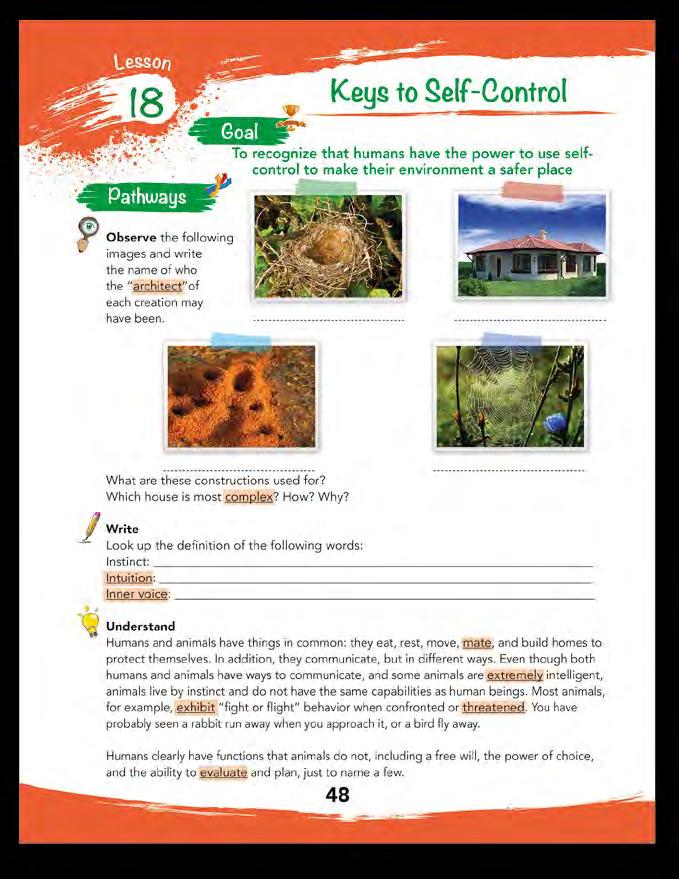
of this section is help the students recognize the profound difference between humans and animals in our ability to regulate our basic instincts and behavioral impulses.
Understand: Please read this section with the students. Lead a brief discussion on the differences between animals and humans, particularly in regard to the complexity of the human brain. Talk about the “fight or flight” (and even the freeze) instinct that exists in virtually all living creatures, humans included. What are the factors that determine fight or flight for humans?
Students may bring various opinions and background knowledge regarding human intuition, inner voice, conscience, sixth sense and the spiritual realm to explain the decision-making process that exists in humans as opposed to animals. Students may bring up personal experiences, including physical encounters, narrow escapes, or the belief in a higher power. Be sure to encourage free and open discussion
without making judgments, no matter what their personal beliefs are. If the debate becomes heated or veers off course, steer the students back to the purpose of the lesson (i.e., developing healthier means of self-control).
Role Play: Students will roleplay various situations where impulse control would be preferable to acting on raw instinct, and why. Allow ample time for students to switch roles in order to practice both sides of the situation. Discuss the various scenarios as a class, with a focus on self-control strategies and the role of intuition (or adhering to their inner voice). Some skills and strategies for practicing self-control are listed below and can help lead discussion. Strategies for Self-Regulation: goal trackers; impulse control journals; habit trackers; adjusting time to complete tasks; counting to 3 before speaking or acting (or to 10, if you are really angry or triggered); self-rewards; acting out situations; positive thought journals; creating a schedule; breaking down large tasks into smaller pieces; selftalk.
Reflect: The workbook questions allow the students to analyze their thoughts and responses when placed in potential scenarios. Encourage the students to be as honest as possible in their journal time. Remind them that there are no right or wrong answers. Their journal time is an opportunity to reflect, grow, and create self-improvement goals. Help them recognize the power contained in their personal choices, and to realize their choices lead to results and consequences that they will either enjoy or regret.

It is important for children to understand that they can control what they think, say and do by being aware of their actions and practicing self-control.
My Best Me textbook, journal, paper, pencil, audiovisual equipment
*Book Suggestion: Power Up to Fight Pollution by Lisa Bullard, one of the books from the “Planet Protector” series. Resources
Student Worksheet: 4yu.info/?i=V598522
Family Engagement: 4yu.info/?i=V598572
Video: Peer pressure - Link: 4yu.info/?i=95211
proactive, relax, assume, littered, graffiti, ideal Motivation
Peer pressure can present itself in many different ways. Many children feel the need to follow the behaviors of a group of peers rather than trust their own instincts and do what they know is right. This lesson addresses how to handle peer pressure both assertively and respectfully, especially when standing up for the natural environment.
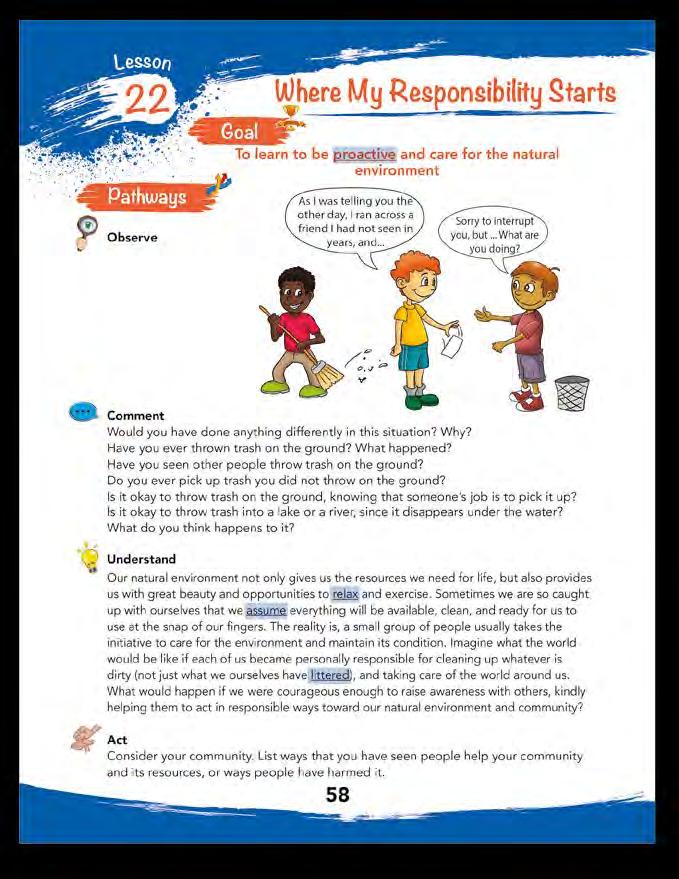
As humans, we tend to see the errors of others easily, while ignoring our own flaws. Children are no different. In this lesson, it is important for students to become aware of their own “blind spots” regarding their community and environment, so as not to merely point out the flaws of others. While your students might not throw trash on the ground, other behaviors might exhibit their unwise or irresponsible management of natural resources (Do they leave the lights on, let the water run in the shower, throw away otherwise edible food?). As they work through the lesson, emphasize the fact that change starts with each individual’s contribution, as we become more responsible and better stewards of the environment we share. As a result, each student can be a catalyst to encourage others—peers and adults alike—to take better care of the community and the environment. Actions speak far louder than words!
The students will identify ways to advocate for the protection and care of the natural environment in their community. They will discover how to become more responsible. Observe: Students will observe the images and read the speech balloons. They might justify throwing trash on the ground because people are paid to clean it up. In the cartoon, the bystander is presented with a moral dilemma, since he has to make a choice whether to ignore the situation or confront his “litter bug” friend. This is an introduction to the idea that standing up for what is right may be difficult. What are the alternatives? What if the litterer is not confronted and walks on, leaving the trash on the ground? Should the person addressing him pick up the trash or should it just be left
for the city cleaners? Have students draw/write their own images presenting a parallel situation of their own choosing. Encourage them to include speech balloons if they choose to depict a bystander confronting the offender. Invite the students to write a brief conclusion about how the situation ends.
Comment: Students will respond to the images presented in the workbook, discussing and analyzing their own feelings about standing up for the environment and living out their personal convictions. Talk about other common situations where they may be able to use their influence to address irresponsible actions on the part of others when they notice them. Take time to talk about areas in which they themselves need to improve, yet are critical of others. Allow students to elaborate a skit, poem, or story creating a scenario where peer pressure induces action related to the natural environment in their community.
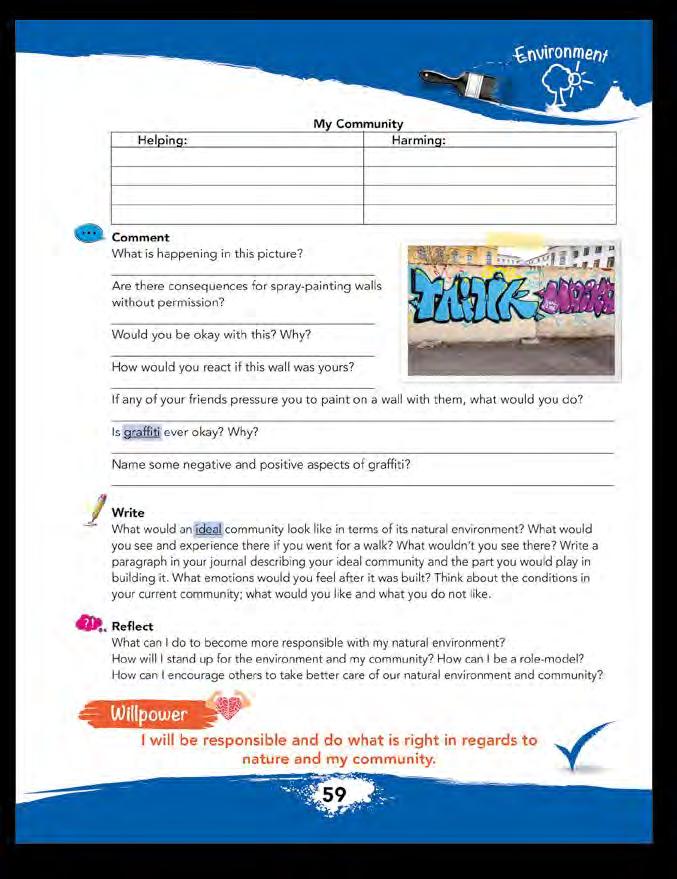
Understand: Read and discuss with the students what it means to influence others to become
aware of the effects of their behavior on the things around them and act responsibly toward them. You could refer to the title of this lesson and use it to generate a start up question: “Where do our responsibilities begin and end?” Emphasize the strong positive influence each person exerts when acting as an example.
Act: Students can work in groups. They will consider their own communities and how well they are being maintained. Ideas to consider are the cleanliness of parks, the availability of recycling bins and trash cans in public spaces, the accessibility of public transportation (to reduce pollution), bike lanes and trails, treatment of animals and their habitats, preservation of land, etc.
Comment: Students will observe a photo of graffiti art on a wall, which often is done under peer pressure and not as an approved project, and therefore unlikely to be helpful to the community or to the natural environment. The students will respond to the photo considering their personal feelings about graffiti as well as about being pressured into doing something they do not want to do.
Write: Students write or type a paragraph about what their ideal community would look like. Inspire them to take into consideration how complex an ideal community is and the effort it would require to keep it in top condition. The purpose of this is to motivate students to take action in their own communities, protecting and making changes towards a cleaner, healthier environment.
Reflect: How can students take a stand for the natural environment?
An important part of being a responsible citizen is advocating for the wellbeing of all that is around them; natural resources, and people, including themselves.
My Best Me textbook, journal, paper, pencil, access to the internet *Book Suggestion: Community Needs: Meeting Needs and Wants in Communities by Jake
Miller.Student Worksheet: 4yu.info/?i=V598526
Family Engagement: 4yu.info/?i=V598576
material, enhance, non-material, compliment, essential, embedded, gratefulness, wealthy, sufficiently, appreciate
We want our students to live like Francis of Assisi or Gandhi and “be the change they wish to see…” It takes time, however, to find meaningful ways for kids to practice sharing who they are and what they have with those around them. Students should develop altruistic traits grounded in their concern for helping others. The first step is to encourage them to acknowledge the abundance in their own lives. From a place of gratitude and contentment, when their eyes are looking outward, students can begin to help others in need.
Students should realize that, regardless of their socio-economic status, everyone has some type of need, whether at home, at school or in their neighborhood. Students have a wealth of gifts that can help meet some of those needs. The key is to be aware of the people around them and to be sensitive to what is going on in their lives. This is quite a challenge when children are immersed in their “screens”. How can we pay attention to others if we are constantly focused on our devices? When we encourage students to become “helping agents” who fulfill the needs of those they are close to, they will start to experience the great satisfaction of giving out of what they have, (Assisi and Gandhi lived very humble lives, sharing what they had with others), and discover the joy that sharing can bring to their lives.
The students will be able to identify and meet the needs of individuals in their community by using their unique gifts and talents.
Observe: Students will observe the pictures and discuss with each other what needs the people have in each photo. The purpose of this introduction is for students to see that all people have needs. Many times we think needy people only have financial needs, but this lesson shows the wide variety of needs people have (some of which we experience in our own lives).
Comment: Students will comment on the needs in their own lives as well as the needs of others. You can do this with the entire class or in smaller groups. The idea is to stimulate discussion among

the students and create awareness that close to them are individuals who need help, which might not be noticeable at first sight.
Understand: Please read this section with the students. Make a list of ways students currently fulfill the needs of others at home or at school. Another idea is to use this time to discuss possible needs in your own school (new students, students by themselves, etc.) and community (the elderly, people with special needs, etc.) and brainstorm ways the class can help meet those needs. Have students identify what skills are required to accomplish this. If possible, have students individually, in small groups, or as a class, plan and execute one of their service learning ideas. Another idea is to have students focus on what they have experienced personally when they share of themselves and how they have helped others around them. Let them describe the emotions they felt in this process.
Comment: Students will think about the
needs they perceive in the people surrounding them.
Act: Students will identify individual(s) around them who they perceive have needs. Give them time to brainstorm the various types of needs they think the individual(s) mentioned might have. Are these needs related to food, health, drug abuse, education, emotional issues, or something else? They may work with a partner or in a group to create a poster that highlights the important details of the needs they encounter.
Reflect: To conclude the lesson, have students use the workbook questions to summarize their thoughts. The subject matter may be personal to each student, so a journal entry may be more appropriate than a discussion. Allow students to share their thoughts and help the class to recognize the moments in their lives when they were able to share what they had. Students will discover that they are capable just as they are, and equipped with whatever they have, to share what they have with others. In other words, it’s not the amount that counts, but the act and attitude of giving selflessly.

An important part of being an active member of a community is to help others with their needs.